 For American oystercatchers, every chick counts.
That’s why a study of the role of predator control on Georgia’s nesting oystercatchers is providing promising insight into helping conserve these big and rare red-beaked shorebirds.
The two-year project supported by a National Fish and Wildlife Foundation grant through Southern Company’s Power of Flight program -- Southern is the parent company of Georgia Power -- focused on trapping and photographing raccoons, feral hogs and other predators at nesting areas ranging from Little Egg Island Bar to St. Catherines Island. Researchers had predators trapped at some sites, set trail cameras at those and areas that weren’t trapped to assess predator pressure, and monitored oystercatcher nests.
Results are still being analyzed following the close of fieldwork this summer, said project leader Tim Keyes, a wildlife biologist with DNR’s Nongame Conservation Section. But some take-homes are clear.
"We were documenting higher nesting success and higher fledgling rates when we did some trapping,” Keyes said. “… Generally, I think it confirms that a trapping program is necessary in some areas.”
From 121 American oystercatcher pairs documented on Georgia’s coast this year, researchers counted 32 chicks, the most ever recorded and production boosted by fewer, nest-swamping high tides.
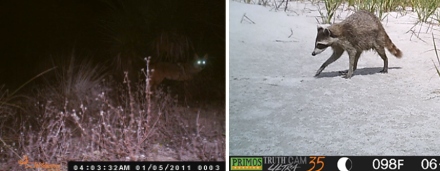
The study data could help determine where and when trapping – which is time-consuming, costly and sometimes contentious – will most benefit oystercatchers.
Keyes said the project also underscores the importance of nesting areas where there are no raccoons, hogs or coyotes, such as on isolated sandbars like Pelican Spit, St. Catherines Island Bar and the spit at Gould’s Inlet.
Yet, not only are these places usually low in elevation, ephemeral and prone to overwash, disturbance by people and pets is another potential negative for nesting shorebirds.
“Some of these non-predator sites are used by boaters, some of whom let their dogs roam.” (Also see “Dog kills rare shorebird.”)
Project partners
Included the University of Georgia, St. Catherines Island, Little St. Simons Island and the U.S. Fish and Wildlife Service.
Back to top.
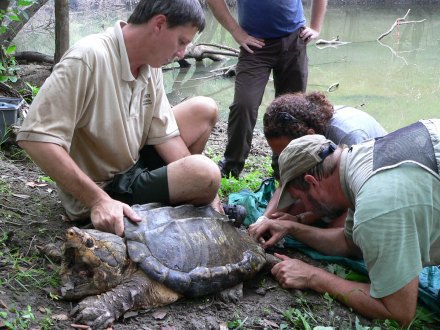 Wildlife tags at work
As North America's largest non-marine turtle, alligator snapping turtles can weigh more than 200 pounds.
That hefty potential, combined with relatively easy trapping, made alligator snappers a cheap meat source for soups in the 1960s and ’70s. The sharp population declines that followed the intense commercial harvest prompted Georgia and other southeastern states to protect this species with the lightning quick jaws and life spans exceeding 100 years (see "Centenarians" below).
However, questions remained; namely, what long-term affects did the harvest have?
For answers, the Nongame Conservation Section began a capture-mark-recapture study of alligator snapping turtles in southwest Georgia’s Spring Creek in 1997. Previous survey results suggested the stream near Colquitt had one of the state’s largest populations. The new study focused on documenting demographics that also could be used to gauge recovery in other harvested populations.
That study ended this summer. Using baited hoop traps, SCUBA gear and snorkels, researchers logged 163 captures of 71 different turtles in a 2.5-mile stretch of Spring Creek.
Nongame Conservation and Auburn University are analyzing data to examine population size and characteristics such as sex ratios, plus growth rates and longevity.
Findings will be used to guide conservation of alligator snappers, in Spring Creek and across the species’ range. (Also see “Parting shot: 150th alligator snapper,” Aug. 23.)
Hard-shelled centenarians
The growth of alligator snapping turtles caught twice or more in the Spring Creek study suggests that males can reach at least 104 years old! While such longevity had been assumed, the findings may be the first documentation that the species can top 100. Researchers used the growth rates of recaptured turtles to create growth curve models estimating longevity. According to the curves, some of the Spring Creek snappers caught were chelydridae centenarians.
Snapper videos
The "Wildlife tags at work" series profiles projects the eagle and hummingbird license plates support. Tag sales and renewals account for about half the revenue raised to conserve Georgia’s nongame wildlife, rare plants and natural habitats. The Nongame Conservation Section does not receive state funds for this vital work. Comments?
Back to top.
Noteworthy
Feral hogs are the target of a new Georgia initiative, Hunters Helping Farmers. The DNR and Department of Agriculture program aimed at connecting farmers with hog problems and hunters who want to hunt hogs is no “silver bullet,” officials said, but it is another way to help solve issues caused by this invasive species.
Preserving 30,000-plus acres that serve as a military training buffer and wildlife conservation area around Townsend Bombing Range in McIntosh County earned project partners including DNR part of a new conservation award. The Townsend Bombing Range Encroachment Partnering Team and retired Army Brigadier Gen. Bob Barnes, a former senior policy advisor with The Nature Conservancy, were announced as co-winners of the first Nancy Natoli Élan Award for Innovation in Land Conservation at the Land Trust Rally this month. The U.S. Endowment for Forestry and Communities helps coordinate the award, named for Natoli, who led Pentagon efforts to protect military test and training facilities from incompatible development.
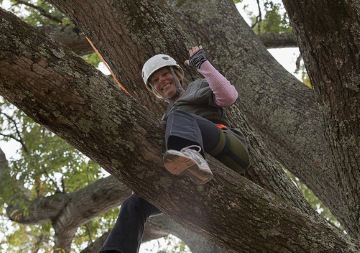 Interested in becoming an outdoors woman? It’s not too late to sign up for the Becoming an Outdoors-Woman workshop Nov. 7-9 at Charlie Elliott Wildlife Center near Mansfield. These educational workshops offer a practical and safe introduction to a range of outdoor recreational skills and activities, from canoeing to hunting, for women of all ages and abilities. And don't miss the center's new annual program calendar!
Learn about owls – birds often associated with Halloween – in the latest Talking Nature Tuesday video with Berkeley Boone, wildlife interpretive specialist at Charlie Elliott Wildlife Center. Boone tackled other wildlife topics that cause some to shiver in previous episodes of the popular video series.
Help a hummer, keep your feeders up this fall and winter. Wildlife biologist Todd Schneider says winter feeders can provide needed food for western U.S. and northwestern Canada hummingbirds such as rufous and calliopes that get off-track during migration and end up wintering in Georgia.
Georgia’s revised State Wildlife Action Plan is on track, with a draft due for public review in April. Technical teams coordinated by the Nongame Conservation Section are updating the 9-year-old plan, identifying pressing conservation needs and developing strategies to address them. The focus: Keep Georgia’s native animals and plants from declining to the point of requiring federal protection as threatened or endangered species. This plan is a comprehensive strategy that guides conservation efforts by DNR and its partners, and is required to receive federal State Wildlife Grants.
 Leaf peepers can check out the fall color through web cameras on Brasstown Bald. Detailed updates are available via the U.S. Forest Service and Georgia State Parks' Leaf Watch.
Names in the news: The Gopher Tortoise Council recently honored nongame senior wildlife biologist John Jensen (left) with a lifetime service award. Joining only two other recipients, Jensen’s long service with the council was noted, including as a state representative, co-chair from 2003-2005, work on a group researching viable minimums for tortoise populations and help in converting two Georgia rattlesnake roundups to wildlife festivals.
Coming up:
Nov. 7-9 – Fall BOW program (Becoming an Outdoors-Woman), Charlie Elliott Wildlife Center, Mansfield.
Nov. 12-14 – Joint Georgia and Southeastern Exotic Pest Plant Council annual conference and symposium, UGA conference center, Athens.
Nov. 15 – Right Whale Festival, Sea Walk Pavilion, Jacksonville Beach, Fla.
April 28-29 – 2015 Georgia Water Resources Conference, UGA Center for Continuing Education, Athens.
Back to top.
|
Headlines
(+video) "Rare Georgia aster in Oaky Woods escapes endangered list," The (Macon) Telegraph
"Georgia program hooks feral hog hunters up with farmers," Southeast Farm Press
"Georgia teacher given $1,000 wildlife education grant," WSB-TV (Atlanta) (and others via AP)
"Ditch to become classroom in Savannah," Savannah Morning News
"Turning to Darwin to solve the mystery of invasive species," The New York Times
"Built-in-billboards: Male bluefin killifish signal different things with different fins," University of Illinois
"Foot-dragging on fish ladder cuts power from Juliette dam," The (Macon) Telegraph
"With law change, tags give wildlife a better chance," Wingbars (Atlanta Audubon Society newsletter)
"Southern Company continues longstanding commitment to Operation Migration's annual whooping crane journey," KPTM-TV (Omaha, Neb.)
"Barr brings passion for the outdoors to DNR," The Daily News Tribune (Cartersville, Ga.)
"Goliath encounter: Puppy-sized spider surprises scientist in rainforest," Fox News
"Keep feeders hanging for winter hummingbirds," The Albany Herald
"New report reveals scale of declines of UK migratory birds wintering in Africa," BirdLife International
"High tides and sea level rise threaten Georgia's coast," Georgia Public Broadcasting
"Climate change not responsible for altering forest tree composition," Penn State University
Video and audio
(audio) "Bats and the white-nose fungus," segment on GPB's "On Second Thought" program (WRAS-FM 88.5, Atlanta) featuring DNR's Trina Morris
"Amazing first look inside endangered bat’s roost," only known video of endangered Florida bonneted bats in a natural roost, U.S. Fish and Wildlife Service
"North Whitfield Middle School students release lake sturgeon in Coosawattee River," DNR Wildlife Resources Division Fisheries Section
"Talking Nature Tuesdays: Owls," with Berkeley Boone, DNR Charlie Elliott Wildlife Center
Back to top.
Parting shot
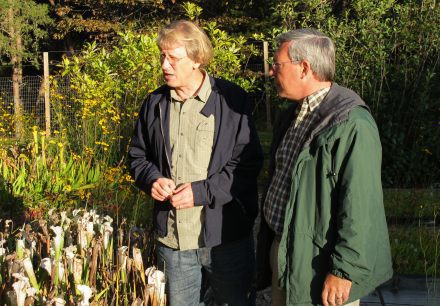 DNR Wildlife Resource Division Director Dan Forster and Ron Determann,
vice president of Atlanta Botanical Garden's Fuqua Conservatories, discuss
conservation holdings at Atlanta Botanical Garden, Gainesville during the annual
Georgia Plant Conservation Alliance meeting held recently at U.S. Forest Service
offices in Gainesville. Participants covered topics varying from protecting rare
plants in Georgia to promoting the creation of plant conservation alliances in other
states, in part to support at-risk species conservation programs coordinated by
the U.S. Fish and Wildlife Service and Southeastern Association of Fish and Wildlife Agencies.
Back to top.
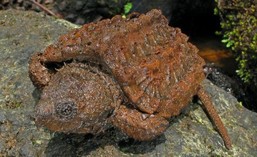 Credits:
** The mystery animal in the masthead is a juvenile alligator snapping turtle that naturalist Alan Cressler photographed in Terrell County. Cressler writes that the turtle's rust color comes from hiding in streams in the iron-laced sediments common in Georgia's Red Hills region.
** Indigo male-on-male combat in southeastern Georgia. Andy Day/The Orianne Society
** DNR's James Leckie with a recently banded American oystercatcher chick from shell rakes near St. Catherines Island. Tim Keyes/Ga. DNR
** Oystercatcher nest cam snapshots of two key predators: raccoons and coyotes. Ga. DNR
** DNR's John Jensen with researchers and a large alligator snapping turtle caught during the Spring Creek project.
** Jensen with Gopher Tortoise Council lifetime service award. Jessica McGuire/Ga. DNR
** Georgia Plant Conservation Alliance meeting participants Dan Forster of DNR and Ron Determann of Atlanta Botanical Garden at the Garden's Gainesville site. Mincy Moffett/Ga. DNR
Back to top.
|